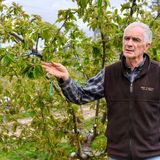RECENT ARTICLES

MELTDOWN: As water dries up, Creston Valley’s farmers worry for the future
In the finale of this four-story series, we look at what the reduced snowpack means for agriculture in the Creston Valley. In case you missed them, read part one on drinking water, part two on outdoor recreation, and part three on wildlife. High temperatures, a declining snowpack and impending water shortages are a climate change trend that have farmers in the Creston Valley worried. Raj Smagh, who has farmed just under 100 acres of cherries since 2010, says farmers have had several bad years of either no crop or poor ones. “It has been like this for three or four years,” he says....… In the finale of this four-story series, we look at what the reduced snowpack means for agriculture in the Creston Valley. In case you missed them, read part one on drinking water, part two on outdoor recreation, and part three on wildlife. High temperatures, a declining snowpack and impending water shortages are a climate change trend that have farmers in the Creston Valley worried. Raj Smagh, who has farmed just under 100 acres of cherries since 2010, says farmers have had several bad years of either no crop or poor ones. “It has been like this for three or four years,” he says....WW…

MELTDOWN: As water dries up, Creston Valley’s farmers worry for the future
In the finale of this four-story series, we look at what the reduced snowpack means for agriculture in the Creston Valley. In case you missed them, read part one on drinking water, part two on outdoor recreation, and part three on wildlife. High temperatures, a declining snowpack and impending water shortages are a climate change trend that have farmers in the Creston Valley worried. Raj Smagh, who has farmed just under 100 acres of cherries since 2010, says farmers have had several bad years of either no crop or poor ones. “It has been like this for three or four years,” he says....… In the finale of this four-story series, we look at what the reduced snowpack means for agriculture in the Creston Valley. In case you missed them, read part one on drinking water, part two on outdoor recreation, and part three on wildlife. High temperatures, a declining snowpack and impending water shortages are a climate change trend that have farmers in the Creston Valley worried. Raj Smagh, who has farmed just under 100 acres of cherries since 2010, says farmers have had several bad years of either no crop or poor ones. “It has been like this for three or four years,” he says....WW…
- Total 2 items
- 1